
The second quarter of the current year saw retailer Walmart Inc reporting its highest ever growth in online sales as consumers used the stimulus checks offered by the United States government to order everything online - from electronics to groceries from their home as they remained inside their homes because of the Covid-19 pandemic.
This unprecedented growth in online sale, which almost was double in growth year on year, in the second quarter allowed the largest retailer of the world to beat analysts’ expectations of profit and same-store sales for the quarter.
The second quarter performance of the company and the huge spike in online demand was persistent even after the peak of the pandemic as restrictions on movement and business was eased. The company reported increased demand and sale of discretionary items such as sneakers and clothes. This trend also allowed Walmart to reduce the number of markdowns or discounts.
But with the fading off of the stimulus, Walmart reported normal sales with only a 4 per cent growth in demand and sale in July.
“The health crisis has created ... both tailwinds and headwinds to our business,” said Chief Financial Officer Brett Biggs on a call with investors. “In Q2, we saw stronger-than-expected sales due in large part to stock-up buying and stimulus spending, but the duration and extent of future government stimulus remains uncertain.”
But with more school districts rolling back of their plans for reopening schools in order to reduce the spread of coronavirus infections in the United States, the back-to-school season has been “choppy,” said Walmart executives, which meant that there was little need for backpacks and uniforms to be bought by consumers.
“Hinting at back-to-school being a little bit weaker or more spread out - and with no guidance - always gives investors an area of concern,” said Randy Hare, portfolio manager at Huntington Private Bank, adding that shares might have traded higher had they done so.
Suppressed demand for its back-to-school selling season because of the uncertainty around reopening of schools was also reported by department store chain Kohl’s.
Wlamart reported better margins in the second quarter because of the government stimulus checks prompting consumers to spend more on pricier items such as home furnishings and apparel even though the company also incurred $1.5 billion in Covid-19 related expenses such as higher wages and bonuses for employees.
With the expansion of the same-day delivery options and pick-up services, there has been rapid growth in the online and grocery businesses of Walmart.
During the quarter,. The company reported a 97 per cent growth in its online sale in the United States. The company also reported a 9.3 per cent year on year growth in sales during the quarter at the company’s US stores that have been open for at least one year.
“The e-commerce sales beat what we expected, yes,” said Huntington’s Hare. “But big picture, companies positioned for curbside pickup and online sales are the ones that are going to benefit. Walmart is one of those companies.”
(Source:www.timesofindia.com)
This unprecedented growth in online sale, which almost was double in growth year on year, in the second quarter allowed the largest retailer of the world to beat analysts’ expectations of profit and same-store sales for the quarter.
The second quarter performance of the company and the huge spike in online demand was persistent even after the peak of the pandemic as restrictions on movement and business was eased. The company reported increased demand and sale of discretionary items such as sneakers and clothes. This trend also allowed Walmart to reduce the number of markdowns or discounts.
But with the fading off of the stimulus, Walmart reported normal sales with only a 4 per cent growth in demand and sale in July.
“The health crisis has created ... both tailwinds and headwinds to our business,” said Chief Financial Officer Brett Biggs on a call with investors. “In Q2, we saw stronger-than-expected sales due in large part to stock-up buying and stimulus spending, but the duration and extent of future government stimulus remains uncertain.”
But with more school districts rolling back of their plans for reopening schools in order to reduce the spread of coronavirus infections in the United States, the back-to-school season has been “choppy,” said Walmart executives, which meant that there was little need for backpacks and uniforms to be bought by consumers.
“Hinting at back-to-school being a little bit weaker or more spread out - and with no guidance - always gives investors an area of concern,” said Randy Hare, portfolio manager at Huntington Private Bank, adding that shares might have traded higher had they done so.
Suppressed demand for its back-to-school selling season because of the uncertainty around reopening of schools was also reported by department store chain Kohl’s.
Wlamart reported better margins in the second quarter because of the government stimulus checks prompting consumers to spend more on pricier items such as home furnishings and apparel even though the company also incurred $1.5 billion in Covid-19 related expenses such as higher wages and bonuses for employees.
With the expansion of the same-day delivery options and pick-up services, there has been rapid growth in the online and grocery businesses of Walmart.
During the quarter,. The company reported a 97 per cent growth in its online sale in the United States. The company also reported a 9.3 per cent year on year growth in sales during the quarter at the company’s US stores that have been open for at least one year.
“The e-commerce sales beat what we expected, yes,” said Huntington’s Hare. “But big picture, companies positioned for curbside pickup and online sales are the ones that are going to benefit. Walmart is one of those companies.”
(Source:www.timesofindia.com)





